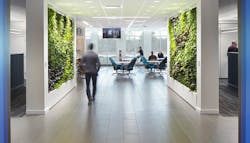When we talk about designing for climate adaptation, we first and foremost concern ourselves with the preservation and protection of human life. While the understood goal of resilient buildings is to physically protect both the property and the people, resiliency can also have positive mental health effects for building occupants. Knowing that increased stress levels have been found to directly cause greater psychological issues including suicide, domestic abuse, and other destructive behaviors, my colleague, David Cordell, and I set out to explore how the interior environment could actually reduce mental distress.
Stress occurs before, during, and after a crisis event. Factors outside of a building can contribute to stress as much as the interior environment. Inability to communicate with loved ones will certainly cause anguish for a family member. Lack of access to potable water and food have physical impacts but can also cause mental strain. While building occupants may not always have much advance notice of an acute event (such as an earthquake or tornado), there are ways the design of a space can impact the mental health of the occupants in those before, during, and after timeframes. Knowing an event will occur in the near future (such as a predicted hurricane) may allow physical preparations to occur, but having that advance notice may actually increase stress levels as one awaits the storm.
Our research project, Weathering the Storm: Mental Health and Resilient Design, proposed links between specific design strategies and the positive psychological benefits they may provide when building occupants are faced with a crisis event. Several studies have already shown direct access to nature and natural elements relieves stress. Installing a green roof on a building provides a number of sustainability benefits—stormwater management, creation of wildlife habitat, decreased urban heat island effect—but such an area can also ease depression and reduce stress levels if available as an outdoor refuge to building occupants who may need to shelter-in-place. Green roofs can also be used to cultivate fruits and vegetables, offering both nutrition and mental reassurance.
Other strategies for resilience planning involve design elements coupled with operations policy. A building may choose to provide alternate transportation options to occupants for use in times of stress. In a flood-prone area, inflatable rafts and air pumps stored on a floor above the projected flood plain may offer a way home (and access to loved ones) during extreme precipitation or storm surges. It also offers a way to retrieve supplies for occupants sheltering during such an event.
Communication of these measures to occupants is also an important factor for reducing stress. Occupants need to know what safeguards the building has in place and be comfortable employing them. When these and other strategies are communicated to building occupants, we believe there may be a lessening of anticipatory stress as people know there are means in place to help them during a crisis event.
Why do we care? What is the true benefit? Mental health is a major factor in quality of life, and improving it may lead to greater workforce productivity and reduced absenteeism. Certain design strategies can promote a greater sense of community connectivity. Employers may see reduced insurance costs related to psychological issues during and after crisis events. Residual or delayed stress—that which stays with individuals long after an event has occurred (Post-Traumatic Stress Disorder, for example)—may even be staved off or lessened when occupants’ mental health is factored into planning for resilience to crisis.
By making our spaces more resilient and communicating that value to tenants, designers can contribute to the improved mental wellbeing of occupants. Protecting against loss of life and property is important, but it should not be the only factor in meeting site-specific vulnerabilities. As we increase awareness of design’s impact, occupants may even begin to seek out buildings that can flex with climate fluctuations. Who knows—we may see resilient design joining the ranks of roof decks and bike rooms as the hot new tenant amenity.
About the Author: Jon Penndorf is a project manager and sustainability leader in Perkins+Will’s Washington, DC office. He is involved in the management and design of a variety of project types, from focused interior renovations to energy management across a full real estate portfolio. Jon is a recipient of the AIA’s Young Architect Award, the 2012 president of the AIA’s DC chapter, and the 2014 chair of the AIA’s Young Architects Forum advisory committee. With over 12 years of professional experience, Jon is engaged in many areas of the architecture community including community leadership, writing, and education.
About the Author
Perkins and Will
Perkins&Will is a firm of remarkable people who are driven by discovery–through their relationships, research, and design. In the simplest sense, our ideas are the precursors for all of our design work. Perkins&Will’s blog features emerging thought leadership from across the firm, inviting an even greater global dialog around learning, wellness, workplace, sustainability, and everything in between. Follow us on Facebook, Instagram, LinkedIn, Twitter, and Vimeo.
